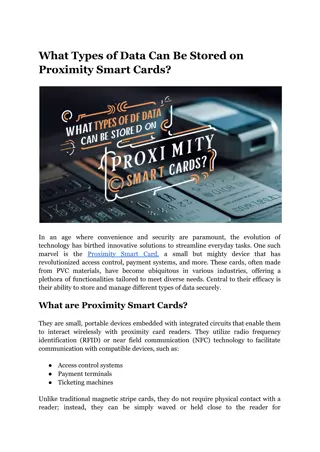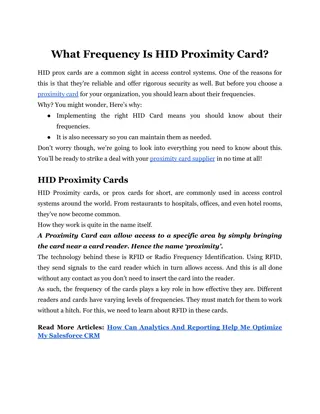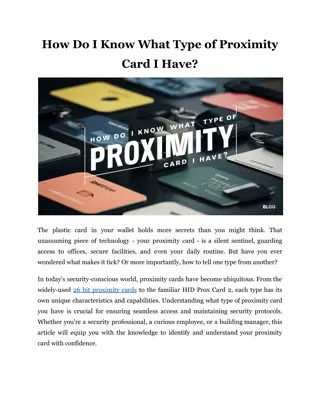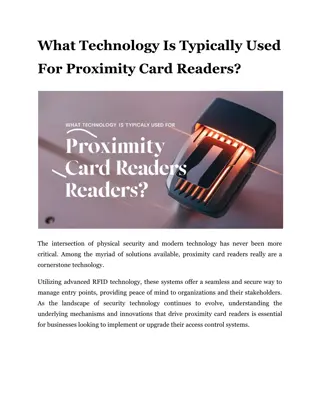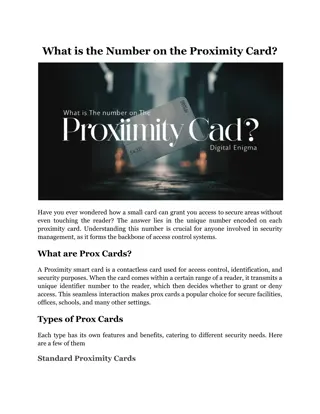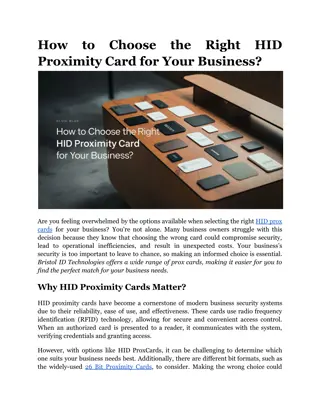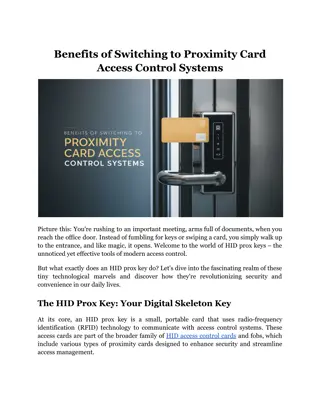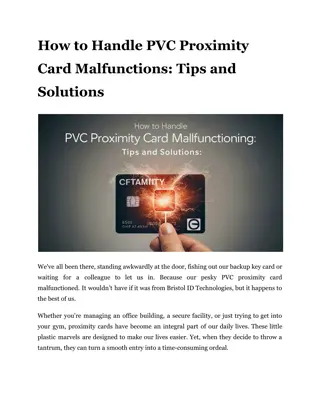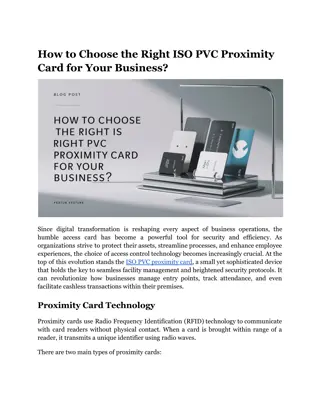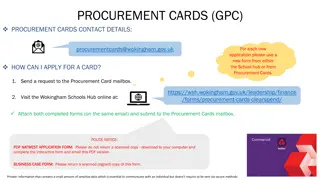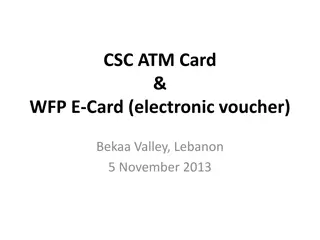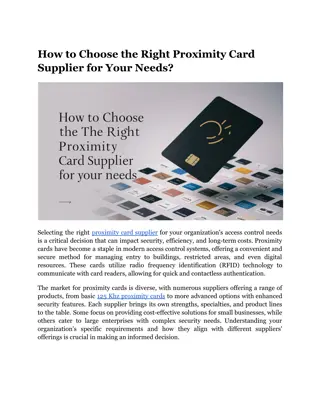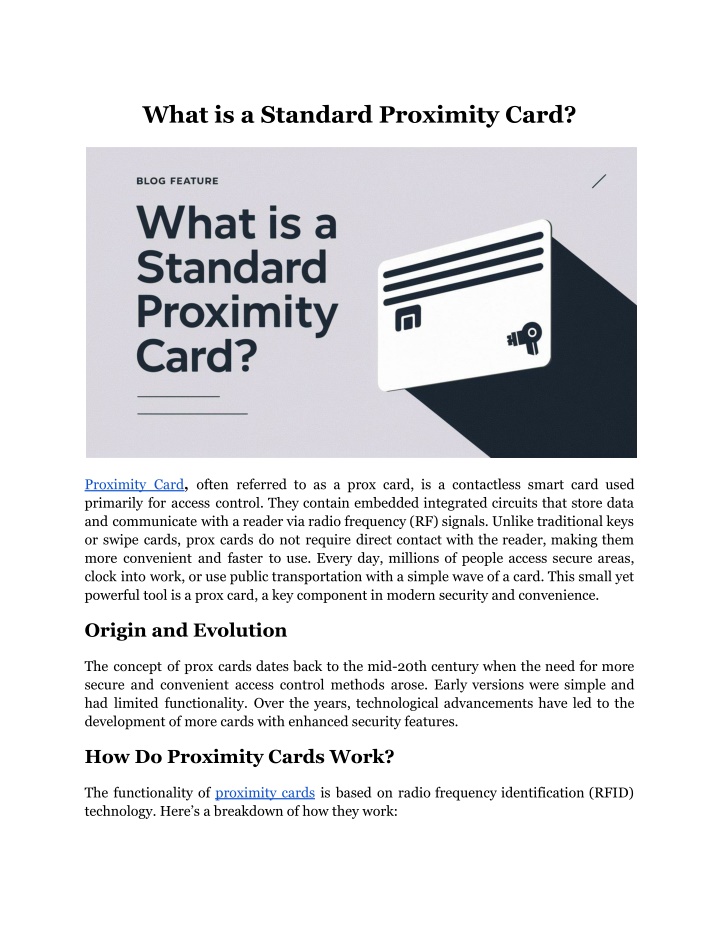
What is a Standard Proximity Card?
Discover what a standard proximity card is, its uses, and benefits in access control systems. Perfect for businesses seeking security solutions.
Download Presentation

Please find below an Image/Link to download the presentation.
The content on the website is provided AS IS for your information and personal use only. It may not be sold, licensed, or shared on other websites without obtaining consent from the author. If you encounter any issues during the download, it is possible that the publisher has removed the file from their server.
You are allowed to download the files provided on this website for personal or commercial use, subject to the condition that they are used lawfully. All files are the property of their respective owners.
The content on the website is provided AS IS for your information and personal use only. It may not be sold, licensed, or shared on other websites without obtaining consent from the author.
E N D
Presentation Transcript
What is a Standard Proximity Card? Proximity Card, often referred to as a prox card, is a contactless smart card used primarily for access control. They contain embedded integrated circuits that store data and communicate with a reader via radio frequency (RF) signals. Unlike traditional keys or swipe cards, prox cards do not require direct contact with the reader, making them more convenient and faster to use. Every day, millions of people access secure areas, clock into work, or use public transportation with a simple wave of a card. This small yet powerful tool is a prox card, a key component in modern security and convenience. Origin and Evolution The concept of prox cards dates back to the mid-20th century when the need for more secure and convenient access control methods arose. Early versions were simple and had limited functionality. Over the years, technological advancements have led to the development of more cards with enhanced security features. How Do Proximity Cards Work? The functionality of proximity cards is based on radio frequency identification (RFID) technology. Here s a breakdown of how they work:
Components of Cards 1. Embedded Microchip: This microchip stores data that identifies the cardholder. 2. Antenna: It transmits and receives radio signals to and from the reader. 3. Card Body: Usually made of durable plastic, the card body protects the internal components. Read More Articles: What is the Lifespan of a Private Jet? Communication with the Reader 1. RF Signal Transmission: When a card is brought near a reader, it emits an RF signal. 2. Reader Activation: The reader, powered by an electrical source, picks up the signal from the card. 3. Data Exchange: The reader transmits a signal to the card, which responds by sending its stored data. 4. Authentication: Lastly, the reader then processes the received data to grant or deny access based on predefined criteria. Frequency Range Cards typically operate at a frequency of 125 kHz or 13.56 MHz. The 125 kHz cards are often referred to as low-frequency (LF) cards, while the 13.56 MHz cards are high-frequency (HF) cards. The choice of frequency depends on the application and required read range. Types of Prox Cards There are several types available, each designed to meet specific needs. The main types include: Passive These cards do not have a built-in power source. Instead, they draw power from the reader s signal. Passive cards are commonly used for access control because they are cost-effective and durable.
Active Active cards come with an internal battery, which allows them to transmit signals over longer distances. These cards are often used in applications requiring a greater read range, such as vehicle identification in parking lots. Semi-Active Also known as battery-assisted passive (BAP) cards, these cards use a combination of internal battery power and energy drawn from the reader. This hybrid approach extends the read range without requiring the card to be continuously powered. Where Are Standard Proximity Cards Used? They are widely used in various settings due to their versatility and security features. Some common applications include: Access Control 1. Corporate Offices: The HID prox card is also used to control access to buildings, rooms, and restricted areas within offices. 2. Educational Institutions: Schools and universities use prox cards to secure entrances, libraries, and other facilities. 3. Healthcare Facilities: Hospitals and clinics use these cards to restrict access to sensitive areas such as operating rooms and medication storage. Time and Attendance Cards are used to track employee attendance. Employees can clock in and out by tapping their cards on a reader, streamlining the process and reducing errors. Parking Systems In parking lots, they are used for vehicle access control. Drivers can enter and exit by presenting their cards to a reader, which is especially useful for secure and efficient parking management. Public Transportation Some cities use cards as fare cards for public transportation systems. Passengers can load money onto their cards and use them to pay for bus, train, or subway rides.
Advantages of Proximity Cards Prox cards offer several benefits that make them a preferred choice for access control and other applications. These advantages include: Convenience 1. Contactless Operation: Users can wave or tap their cards near a reader without needing to remove them from wallets or purses. 2. Speed: The contactless nature of cards speeds up the process of granting access, reducing wait times. Security 1. Encryption: Many cards use encryption to protect the data stored on the card, reducing the risk of unauthorized access. 2. Unique Identification: Each card has a unique identifier, making it difficult to duplicate or tamper with. Durability Prox cards are designed to withstand daily wear and tear. They are often made from durable materials that can endure rough handling and harsh environments. Versatility They can be used in a variety of applications, from building access to payment systems, making them a versatile solution for many needs. Read More Articles: Do Private Jets Fly Out Of Regular Airports? Are There Any Limitations or Loopholes? Despite their many benefits, they have some limitations and drawbacks. These are: Cost While passive HID proximity cards are relatively affordable, active and semi-active cards can be more expensive due to the additional components and technology involved. Limited Read Range They have a limited read range, typically a few inches. This limitation can be a drawback in applications requiring long-distance reads.
Security Risks Although prox cards are generally secure, they are not immune to hacking. Skilled attackers can use advanced techniques to intercept signals or clone cards. Battery Life Active and semi-active prox cards rely on internal batteries, which have a limited lifespan. The need to replace batteries can be inconvenient and costly over time. Future Trends in Proximity Card Technology Some emerging trends are here: Biometric Integration Combining proximity cards with biometric authentication methods, such as fingerprint or facial recognition, can provide an additional layer of security. Mobile Access Smartphones are increasingly being used as access control devices. Mobile apps can emulate these cards, allowing users to gain access using their phones instead of physical cards. Enhanced Security Features Future cards may incorporate advanced encryption techniques and anti-tamper technologies to further protect against unauthorized access and cloning. Environmental Sustainability Manufacturers are exploring eco-friendly materials and energy-efficient components to make prox cards more sustainable. Conclusion Proximity cards have revolutionized the way we manage access control and other applications. While they have some limitations, ongoing advancements in technology continue to enhance their functionality and address their drawbacks.
At Bristol ID Technologies, our HID prox card manufacturing expertise is driven by a commitment to deliver the future. Contact us now to discuss your custom card needs and let us help you bring your vision to life. Site Article: What is a Standard Proximity Card?




